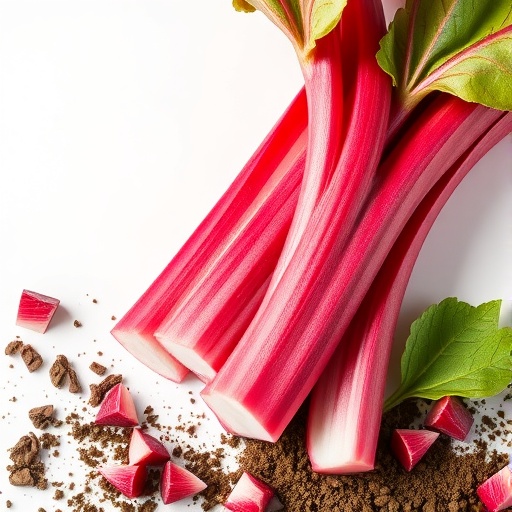Rhubarb, a plant long celebrated for its culinary applications, is now emerging as a subject of intense scientific interest due to its multifaceted health benefits and rich nutritional profile. Recent comprehensive research has shifted focus toward the aboveground parts of rhubarb—not just the well-known stalks but also the leaves—highlighting an array of active compounds that could contribute profoundly to human health. This pivot offers a fresh perspective on rhubarb, elevating it from a mere kitchen staple to a potent functional food with promising therapeutic properties.
The aboveground components of rhubarb encompass a complex matrix of bioactive substances, including anthraquinones, flavonoids, and phenolic acids. These molecules exhibit potent antioxidant capabilities, which are crucial in mitigating oxidative stress—a central factor implicated in aging and multiple chronic diseases. Researchers have started to elucidate how these phytochemicals operate at the cellular level, scavenging free radicals and modulating key signaling pathways that regulate inflammation and cell survival.
A defining feature of rhubarb’s aboveground parts is the abundance of anthraquinones, such as emodin, rhein, and chrysophanol. These compounds not only endow rhubarb with its characteristic pigmentation but also mediate diverse biological effects ranging from anti-inflammatory to anti-cancer activities. Emodin, for example, has been implicated in the inhibition of tumor cell proliferation through modulation of apoptosis-related proteins, representing a potential natural adjunct in oncology therapeutics.
Additionally, the flavonoids isolated from rhubarb exhibit neuroprotective properties that may offer novel interventions for neurodegenerative disorders. Flavonoids influence neurotransmitter systems and protect neuronal cells from oxidative injury. This biochemical activity aligns with epidemiological trends linking diets rich in such compounds with reduced incidence of diseases like Alzheimer’s and Parkinson’s, suggesting rhubarb’s potential role in cognitive health maintenance.
Another significant dimension of rhubarb’s aboveground fraction is its influence on metabolic health. The active ingredients partake in the modulation of glucose and lipid metabolism, providing evidential groundwork for their application in combating metabolic syndrome and type 2 diabetes. Mechanistic studies have revealed that these compounds enhance insulin sensitivity and inhibit adipogenesis, offering a natural route to manage excessive fat accumulation and insulin resistance.
Beyond metabolic regulation, rhubarb’s bioactive compounds demonstrate compelling antimicrobial activities. They exert inhibitory effects against a spectrum of pathogenic bacteria and fungi, which raises the possibility of using rhubarb extracts in food preservation or alternative antimicrobial therapies. This is especially pertinent given the global surge in antibiotic resistance and the urgent need for novel plant-based antimicrobials.
Nutritionally, the aboveground parts of rhubarb are rich sources of vitamins and minerals. High levels of vitamin K, essential for blood coagulation and bone metabolism, have been quantified along with appreciable amounts of calcium, manganese, and dietary fiber. These nutrients support cardiovascular health, skeletal integrity, and gastrointestinal function, making rhubarb a comprehensive dietary component beyond its phytochemical constituents.
The intense pigmentation of rhubarb leaves, attributable to anthraquinones and flavonoids, also indicates their antioxidant intensity. This relationship between pigment and antioxidant capacity underscores how the plant’s visual cues can signify its biochemical utility. Employing advanced chromatographic and spectroscopic techniques, scientists have mapped the concentration gradients of these compounds across various rhubarb species and environmental conditions, refining our understanding of their biosynthesis.
Toxicological evaluations present critical insights, as certain anthraquinones can exert laxative effects or pose risks at high dosages. Controlled consumption and processing methods are imperative to harness rhubarb’s benefits safely. Modern techniques such as optimized extraction and purification have been developed to maximize efficacy while minimizing adverse reactions, marking a convergence of traditional knowledge and contemporary science.
Moreover, the pharmacokinetics of rhubarb’s active ingredients reveal their absorption, distribution, metabolism, and excretion within the human body, which is vital for designing effective dosage regimens. Studies involving human cell lines and animal models help delineate these pathways, offering clues about bioavailability and interaction with other drugs or nutrients. This research lays the groundwork for evidence-based inclusion of rhubarb in clinical nutrition and phytotherapy.
Environmental aspects affecting the bioactive composition of rhubarb have recently gained attention, emphasizing how soil type, climate, and cultivation practices modulate phytochemical profiles. Understanding these variables is essential for standardizing quality and potency, especially when advancing rhubarb-derived products to commercial markets geared toward health-conscious consumers.
From an industrial perspective, the valorization of rhubarb’s aboveground biomass presents a sustainable approach. Currently, much rhubarb leaf material is discarded due to concerns over toxicity; however, with refined processing, this resource can be transformed into valuable nutraceuticals and functional food additives. This approach aligns with circular economy principles, advocating for waste reduction and maximizing the utility of agricultural outputs.
Notably, rhubarb’s integration into modern diets could confer synergistic health benefits when combined with other bioactive-rich foods. Its polyphenolic compounds may interact beneficially with gut microbiota, fostering an environment that supports metabolic and immune health. Emerging research is investigating these microbiome-mediated mechanisms, opening new vistas in personalized nutrition.
The resurgence of interest in traditional medicinal plants like rhubarb underscores a broader trend in contemporary science that bridges ethnobotany and molecular biology. This integrative strategy not only honors historical usage but also subjects ancient remedies to rigorous scientific scrutiny, enabling the identification of active principles and therapeutic targets with precision.
In conclusion, the aboveground parts of rhubarb represent a potent reservoir of bioactive compounds with extensive health-promoting effects. Ongoing research continues to unravel their molecular underpinnings, nutritional benefits, and practical applications, heralding a new era in which rhubarb transcends its culinary origins to become a cornerstone of functional food and medicinal science. As scientists, clinicians, and consumers converge in their appreciation of rhubarb, this humble plant could indeed shift paradigms in preventive health and natural therapeutics.
Subject of Research: Active ingredients, nutritional values, and health-promoting effects of the aboveground parts of rhubarb
Article Title: Active ingredients, nutrition values and health-promoting effects of aboveground parts of rhubarb: a review
Article References:
Wang, P., Liu, Z., Ma, B. et al. Active ingredients, nutrition values and health-promoting effects of aboveground parts of rhubarb: a review.
Food Sci Biotechnol (2025). https://doi.org/10.1007/s10068-025-01919-7
Image Credits: AI Generated
DOI: https://doi.org/10.1007/s10068-025-01919-7




